Situated in Yuanshan Township, Yilan, Shuanglianpi is home to two remarkable "treasures." It features a rare, large-scale natural "floating island"—a unique floating forest formed by overlapping layers of various plants and organic matter, resembling a massive floating grass mat sturdy enough to support forest growth. Additionally, the area harbors over a hundred species of aquatic plants, including 15 exceptionally rare and endangered species.
The pristine natural environment of Shuanglianpi was once targeted for commercial development. Fortunately, through the efforts of the Yilan County Government and environmental advocates, it has been designated as a Wildlife Sanctuary and a Nationally Important Wetland, protected under both the Act on Wildlife Conservation and the Wetland Conservation Act. The Society of Wilderness (SOW) has been actively working to restore endangered plant species in the area while mobilizing volunteers to remove invasive species, quietly safeguarding Shuanglianpi.
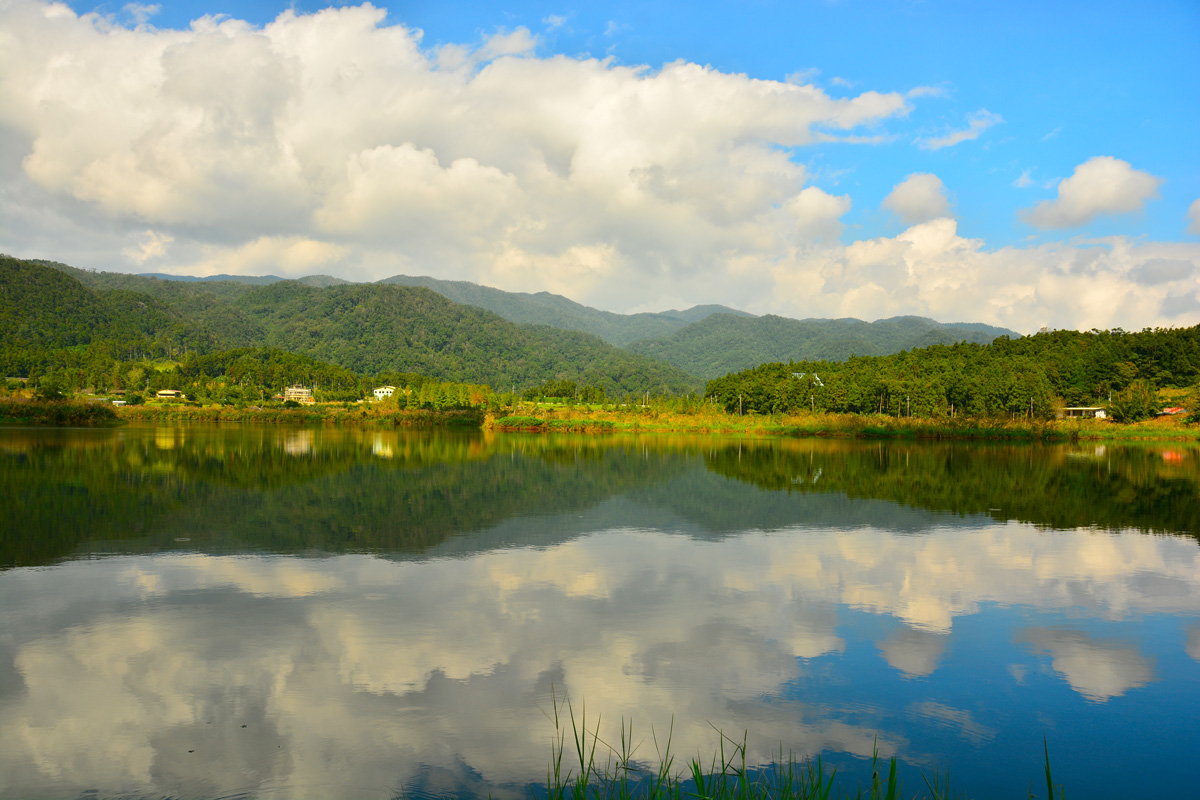
The Scenic Shuanglianpi (Photo Credit: Society of Wilderness, Yilan Division)
Shuanglianpi Holds Ecological Significance, Striving to Revive the Splendor of Aquatic Plants
Hsin-Hsiung Yeh, head of the SOW Yilan Division, notes that Shuanglianpi is home to as many as 112 species of aquatic plants, accounting for about one-third of all aquatic plant species in Taiwan. Among these are Taiwan’s endemic species, with 15 listed in the Red List of Taiwan as endangered. (Editor’s note: To prevent plant hunters from targeting the area, this report does not disclose all endangered species found in Shuanglianpi.) This highlights why preserving Shuanglianpi’s environment is highly "cost-effective" in terms of conservation value. Moreover, Shuanglianpi holds historical significance for the SOW, as it was the first site the organization prioritized after its founding...
In addition, the floating island at Shuanglianpi is an extremely rare phenomenon. It is formed by the intertwined roots and stems of plants. Although its current state is less vibrant than it was more than 20 years ago, the floating island once supported a dense forest with trees reaching 5 to 6 meters in height. During typhoons, this lush forest would drift across the water’s surface. The unique lakescape—a floating island spanning nearly four hectares and supporting an extensive forest—is exceptionally rare and remarkable, even on a global scale.
Yeh explained that the areas surrounding Shuanglianpi are privately owned, with most farmers practicing conventional farming. When the Fushan Botanical Garden opened to the public in 1993, Taiwan was experiencing a domestic tourism boom. Attracted by the scenic beauty of Shuanglianpi, a developer sought to capitalize on the botanical garden's popularity. He purchased large tracts of land with plans to build a leisure resort, featuring accommodations, dining, and recreational facilities for visitors heading to the botanical garden.
Much like how old buildings often "mysteriously" catch fire after being designated as historic sites, environmental groups trying to halt development at Shuanglianpi faced a similar challenge. After environmentalists highlighted the area's many rare plant species, the developer suddenly brought in excavators and began aggressively clearing aquatic plants along the lake's edges. Initially, SOW planned to crowdfund to purchase the land, but the cost proved prohibitive. Fortunately, the Yilan County Government stepped in, designating Shuanglianpi as a protected area and acquiring the land through expropriation, thus preserving a lifeline for its diverse creatures.
Yeh stated that Shuanglianpi is a paradise for aquatic plants and a rare natural resource in Taiwan. With the support and permission of the Yilan County Government, the SOW established a trial aquatic plant sanctuary within the Shuanglianpi protected area. Their goal is to create a "local seed bank" for Shuanglianpi, focusing on in-situ restoration. They hope that one day these plants will return to their original habitats, restoring the vibrant scenery of submerged, floating, and emergent plants growing in harmony at Shuanglianpi.
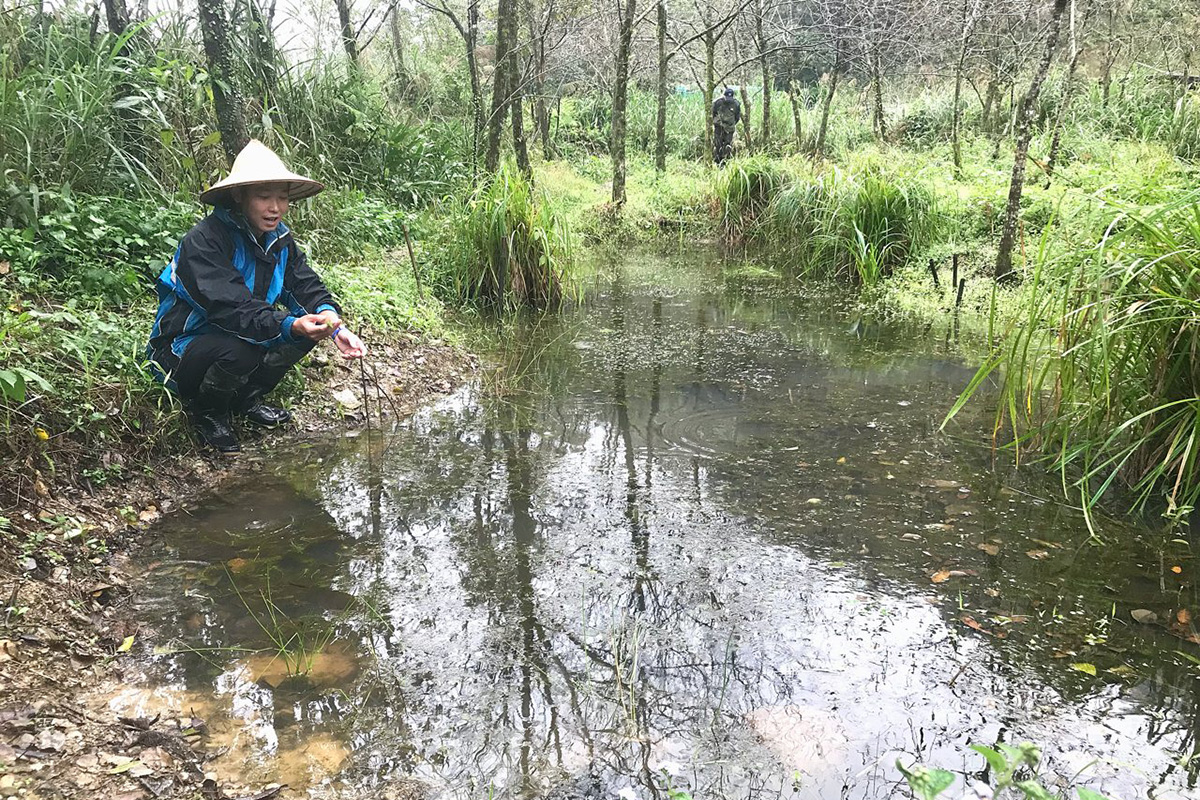
Hung-Yi Huang details the challenges of protecting endangered plants at Shuanglianpi. (Photo by Yang Yu-Yun)
The Numerous Challenges of Restoring Endangered Plants
Hung-Yi Huang, head of the SOW research team, led reporters into the "sanctuary area," where five ponds of varying sizes and depths are used to restore different aquatic plants. Huang crouched down, reached into one of the ponds, and pulled out a yellow-flowered golden bladderwort. “This is a carnivorous plant, and its restoration is extremely challenging,” he explained. Later, in collaboration with the Fushan Research Center, the plants were transplanted to a pond surrounded by willows, which helped reduce sunlight exposure and stabilize the water temperature. As a result, the golden bladderwort now thrives in its new habitat.
"The restoration of Ludwigia ovalis was initially limited to a small area," Huang explained. He noted that the plant is highly susceptible to insect damage and leaf rot. Stabilizing the seed source of this endangered plant required a tremendous amount of effort and manpower.
He then introduced the spike rush (Eleocharis ochrostachys), an emergent plant from the sedge family, which is currently thriving on the floating island. However, the SOW continues to work on its restoration and conservation in the "sanctuary area" as its population remains quite limited in Taiwan. Additionally, the rare marshweeds had completely disappeared after 2003, and people believed it to be extinct. However, during habitat restoration efforts at Shuanglianpi, the SOW unintentionally revived the plant's seed bank in the soil, allowing it to sprout and grow once again.
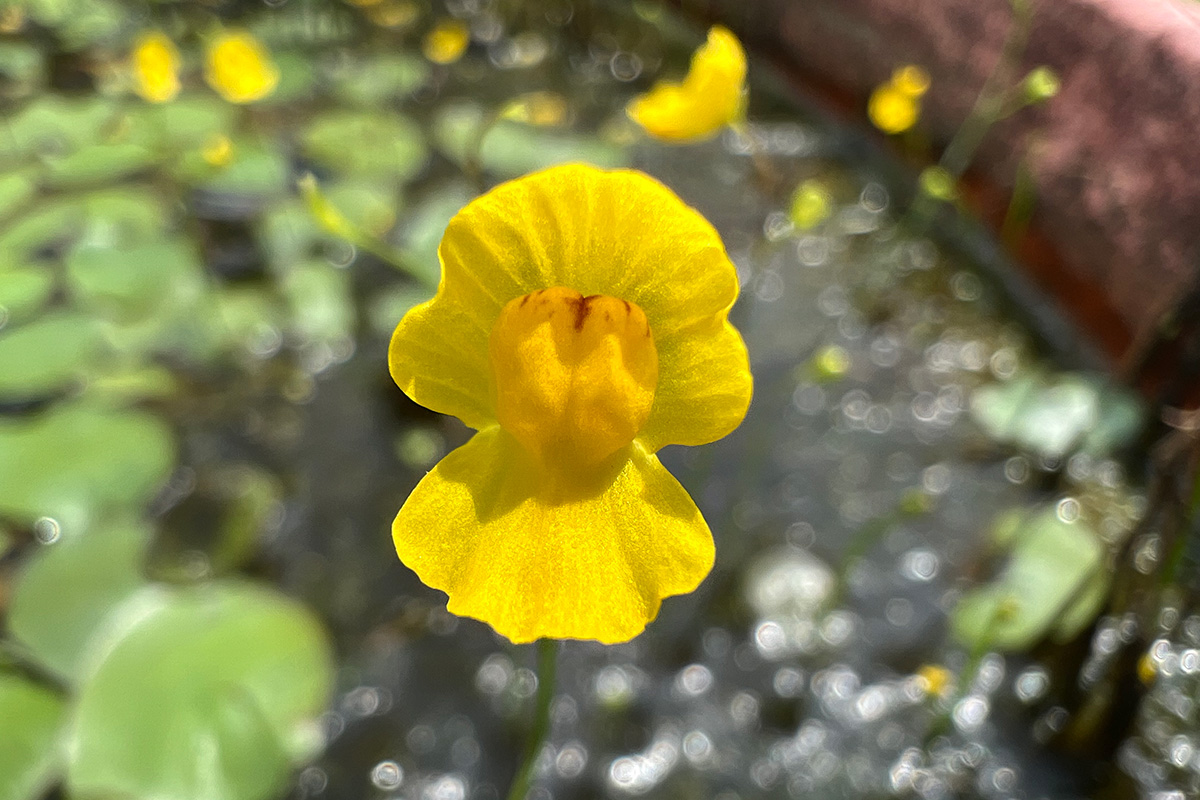
The flowers of the humped bladderwort. (Photo by Pei-Jyun Shih; Photo Credit: SOW Yilan Division)
Huang emphasized that this is what makes plants so fascinating: they rely on seeds to sustain their populations, with some seeds remaining viable even after a century. "The seeds of the marshweeds are less than 0.1 cm in size, and finding them was purely by chance," he remarked. Scholars have conducted taxonomic research on the marshweeds at Shuanglianpi and believe it could be a new species. However, this species has not yet been officially published and lacks a formal Latin name, so it is currently referred to by its Chinese name, "Taiwan marshweeds."
"These aquatic plants are particularly vulnerable because they are highly sensitive to their environment," Huang explained. The "sanctuary area" was once farmland, and after the SOW leveled the land, diverted water, and created ponds, they discovered the water was severely eutrophic. "This was due to past overuse of fertilizers," he added.
They gradually improved the environment and patrol the area year-round. In addition to weeding, pest control, and removing apple snails, they closely monitor changes in water levels. Huang Hung-Yi recalls a year when heavy rainfall caused external water to flow into the sanctuary, bringing with it thousands of golden apple snails. Volunteers collected a large bucket of apple snails daily. Even a single day's lapse in effort could allow the snails to consume a small patch of plants that would take one to two years to regrow—all in just one night. "I feel that environmental destruction happens quickly, but restoration requires an effort a thousand times greater," he said.
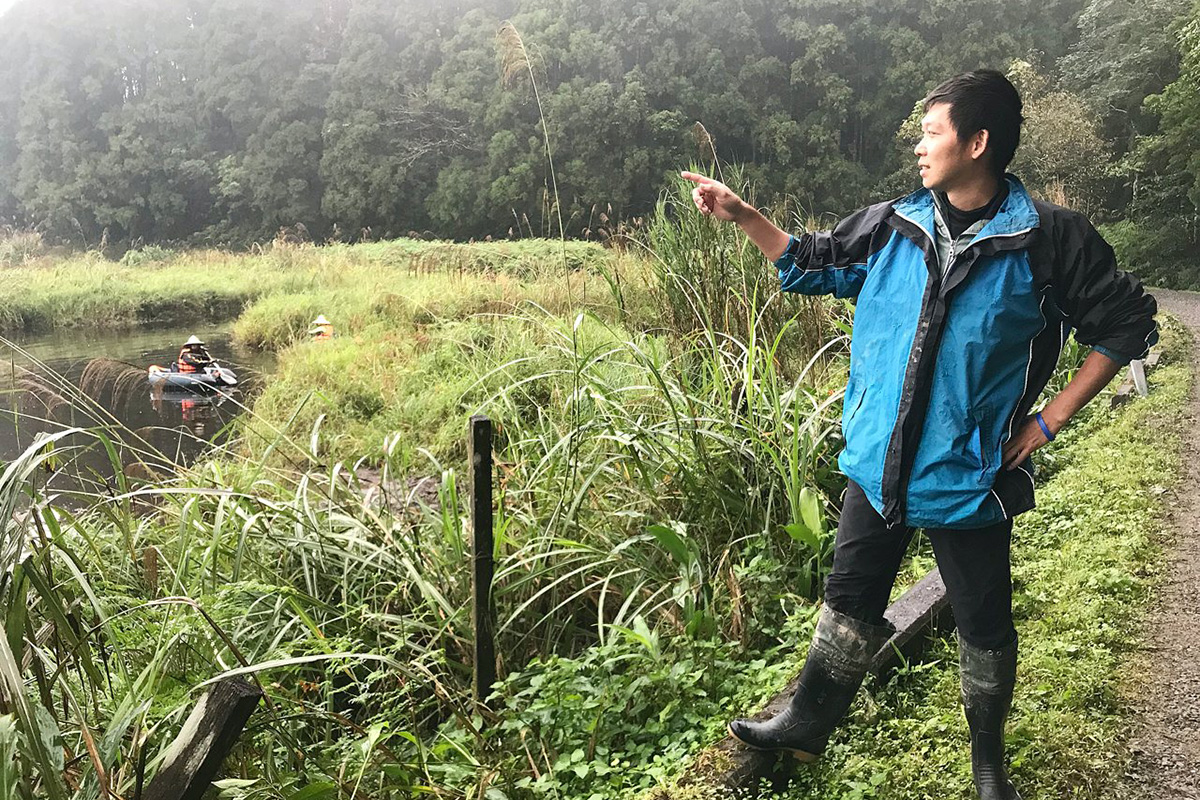
Hung-Yi Huang “recruits” his junior and cousin, forming a task force dedicated to the cleanup of giant salvinia. (Photo by Yu-Yun Yang)
High-Reward Contract Farming for Eco-Friendly Agriculture: Protecting the Environment While Providing Farmers Peace of Mind
Pei-Jyun Shih, a specialist from the SOW Habitat Protection, shared her insights. She mentioned that marshweed blooms subtly each year, with only scattered tiny, pale purple flowers. However, as long as they bloom, they can produce seeds and propagate. Restoration work cannot be rushed. Yet one day, when she entered the sanctuary area, she was surprised to find a large cluster of marshweed’s purple flowers. "I just knelt down right there!" she recalled. The plants deeply moved her with their resilience, overwhelming her with emotion. "I truly felt that I had done something good," she said.
Shih's work also involves assisting farmers in transitioning from conventional farming to eco-friendly practices, avoiding the use of pesticides around Shuanglianpi to protect the aquatic plants and the environment. Currently, the SOW has contract agreements with four farmers, covering 1.2 hectares of farmland. The farmers only need to adhere to the principles of "no pesticide use" and "no chemical fertilizers" without worrying about the harvest. The Society either distributes the products within the community or donates them to local charities. It is hoped that the income from these contracts will encourage more farmers to join the movement toward environmentally friendly farming practices.
Guojian Gao, a long-time collaborator with the SOW, shared that he enjoys seeing children pick vegetables in his fields. "Not using chemicals makes me feel like I’m making a positive contribution to the environment," he said. Similarly, 86-year-old Ruishiung Luo acknowledged that working with the Society secures his livelihood, freeing him from concerns over harvest fluctuations or vegetable prices. The Society also mobilizes volunteers to assist farmers with weeding and pest control, making eco-friendly farming more manageable.
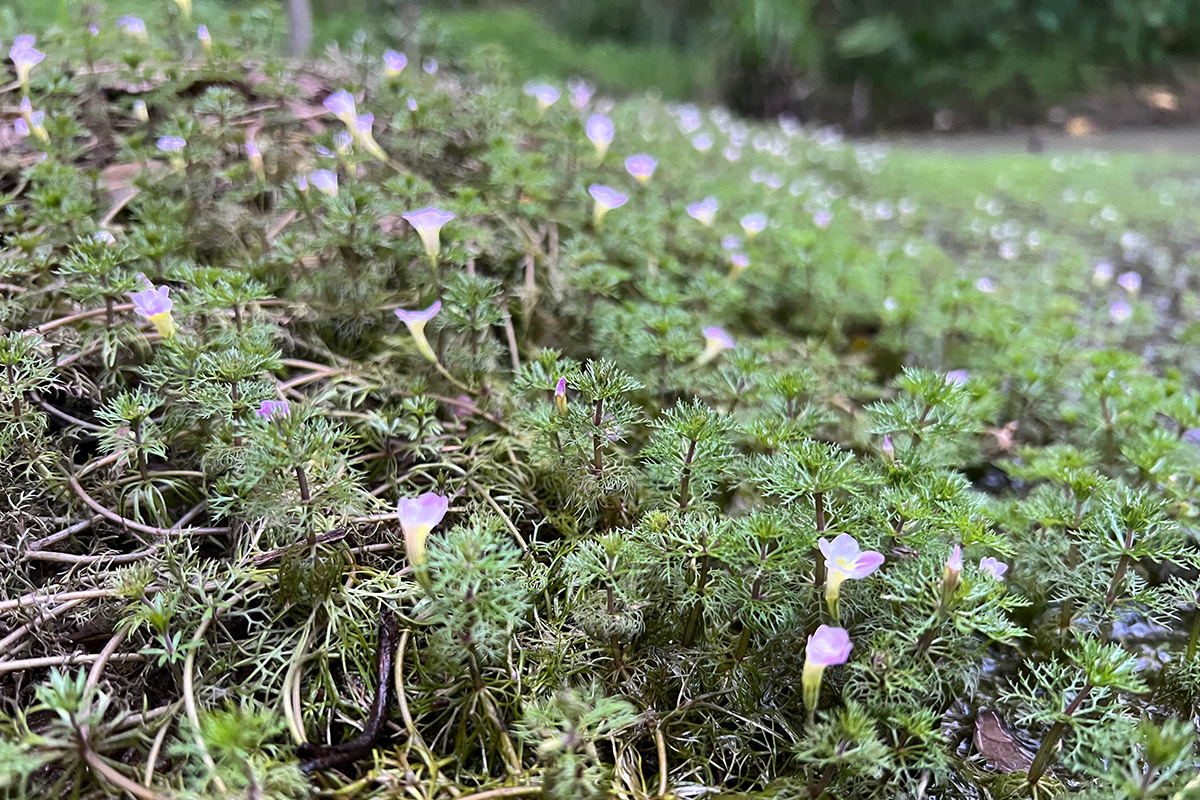
The blooming of marshweed symbolizes the ability of this endangered plant to produce seeds and propagate. (Photo by Pei-Jyun Shi; Photo Credit: SOW Yilan Division)
The removal of giant salvinia is a challenging task, with volunteers providing the majority of the labor
Volunteers are the SOW's most valuable asset. The task of removing the invasive giant salvinia at Shuanglianpi relies entirely on their dedicated efforts.
Huang explained that giant salvinia, native to Brazil and commonly used as an ornamental aquatic plant, was introduced to Taiwan at an untraceable time. Its highly effective reproduction makes it a powerful invasive species worldwide. In Europe and America, giant salvinia has caused significant damage to reservoirs, hydroelectric plants, and other infrastructure. When it covers a waterbody—sometimes up to one or two meters deep—it can suffocate aquatic animals, block photosynthesis, and cause plants to wither.
Fortunately, floating islands have helped restrain the giant salvinia at Shuanglianpi in areas with wild water caltrop. The SOW discovered this during a December survey. Although the water surface should have been clear at that time, it was covered in lush green. This revealed that the giant salvinia had been hidden beneath the wild water caltrop leaves, preventing early detection, and had spread over a large area.
However, Shuanglianpi is home to many endangered plants, making the use of herbicides unsuitable for giant salvinia removal. In other countries, an indigenous Brazilian weevil, the natural enemy of giant salvinia, has been introduced to control its spread. However, Taiwan lacks sufficient foundational knowledge, making the introduction of another invasive species unwise. As a result, the SOW has resorted to the simplest and least impactful method—manual removal. The initial goal was to control its spread, limit its presence in affected areas, and prevent waterfowl from carrying it elsewhere. After years of effort, there seems to be hope for its complete eradication.
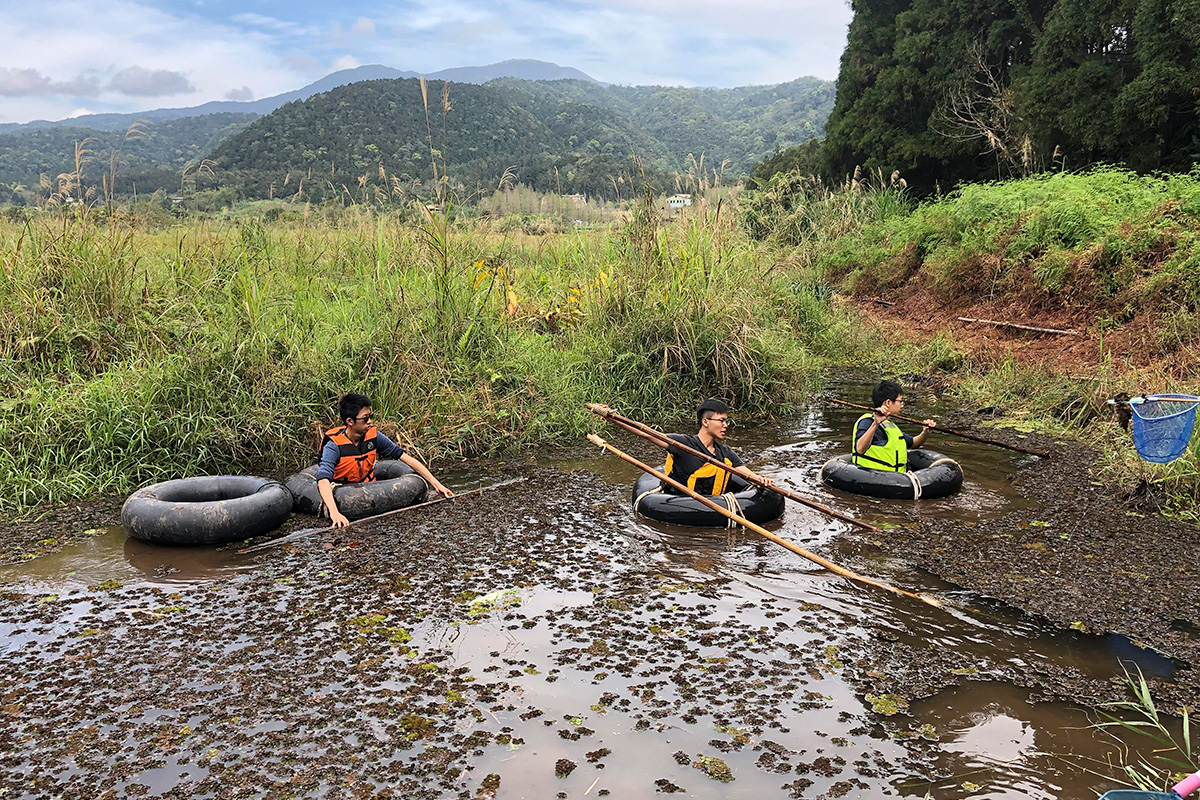
Removal of giant salvinia (Photo by Shou-Yen Chen; Photo Credit: SOW Yilan Division)
Using self-made equipment to clean giant salvinia, volunteers carry on with joy despite the hard work
Removing giant salvinia is no easy task. Initially, when they were abundant, volunteers stood on the shore, scooping them up with nets. However, those hidden among shoreline plants—these "escaped ferns" (as giant salvinia is a type of fern)—now require volunteers to wade into the water to remove them.
Wearing waders and life jackets, volunteers sit in makeshift "rafts" crafted from truck tire inner tubes. Armed with long poles and stainless steel strainer, they splash into the water one by one. Coarse hemp ropes crisscross inside the inner tubes, forming a seat for volunteers to straddle, enabling them to move slowly through the water.
Volunteer Huang Guan-bo admits, "The groin area feels uncomfortable," but adds that it's much safer than the bamboo rafts they used initially. "Luckily," he says, "inner tubes became unavailable, so we switched to Decathlon's Caperlan float tubes for predator fishing. Now, our office looks like a Decathlon showroom." Volunteers jokingly hope Decathlon will sponsor them with more equipment.
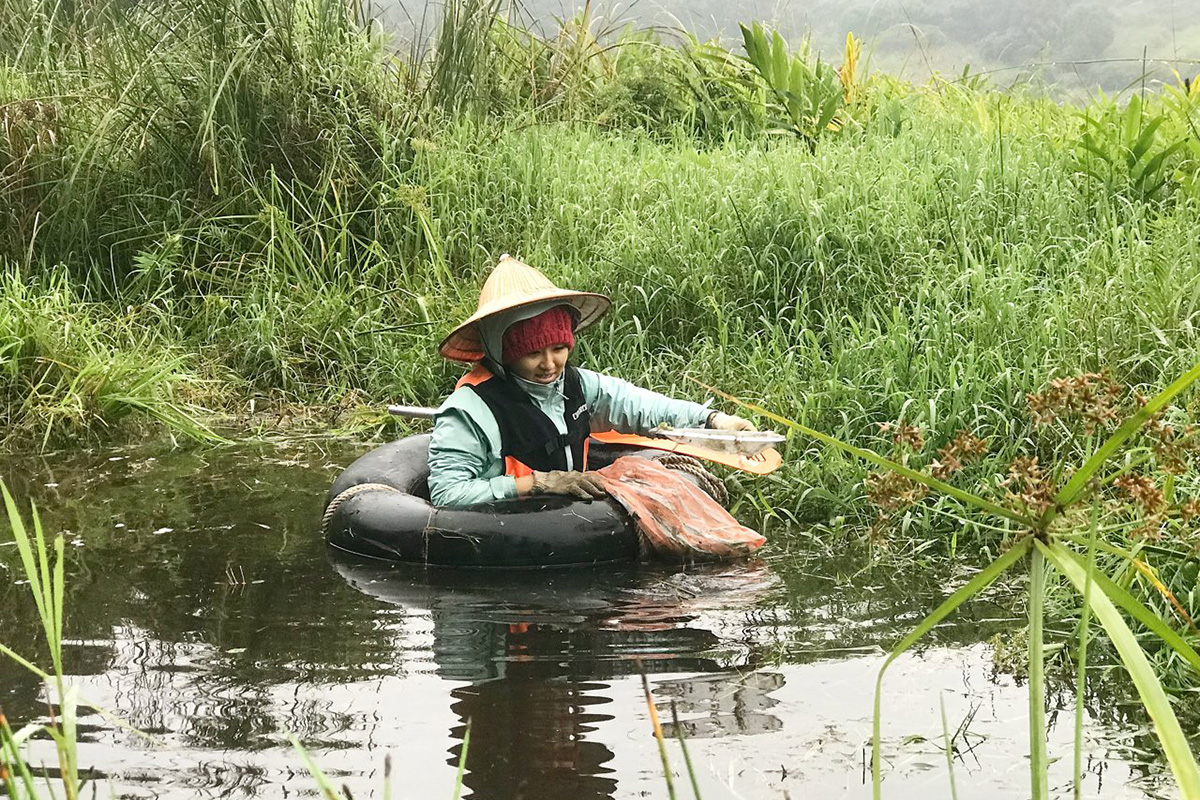
Removing giant salvinia requires enduring intense sunlight and being fully immersed in water, making it a challenging task in both the cold of winter and the heat of summer. (Photo by Yu-yun Yang)
In hot weather, there's no shade overhead, and in the cold, spending the entire day in the water leaves you numb from the chill. The banks are lined with sharp golden beaksedge that can cut you, and using the restroom requires removing your gear and driving as a group to a Tudigong temple (a folk deity known as the "Lord of the Land") a kilometer away. Despite these hardships, why do they still willingly take on this difficult task?
Guan-bo Huang and Ming-wei Chung, juniors of Huang Heng-yi, were introduced to the project in their first year of university and have been working on it for five years. Chung noted, "It's a long-term battle. Initially, it covered an entire area, but now it's reduced to a small section, which feels very rewarding." Huang Hung-bin, Huang Hung-yi's cousin, shared that he enjoys working with everyone and finds joy in caring for the environment. However, he added, "When the weather is cold, it's not as much fun."
Shih added that Wistron staff regularly assist in clearing invasive species. Coming from the high-pressure tech industry, they find the "simple and repetitive" work in nature to be a form of "moving meditation."
Dedicated to protecting the environment, ensuring future generations can appreciate and connect with it
Yeh noted that SOW has five full-time staff at Shuanglianpi, "which is unique among nonprofit organizations in Taiwan." However, most people remain unaware of these endangered plants. If they were to go extinct, what would happen? Why invest so much manpower and funding to protect them?
Hong-yi Huang answers these questions from three perspectives. First, Shuanglianpi is a water source for Yuanshan residents, and aquatic plants help purify the water. Second, clean water attracts waterfowl, while pangolins, crab-eating mongooses, and civet cats also thrive in the area, making it ecologically valuable. Third, these aquatic plants have economic value, such as the enzymes in watershield being researched by National Ilan University.
Even setting aside profit and benefits, "nature is an encyclopedia full of surprises, and it is our responsibility to ensure future generations can read and understand it," Huang concluded emotionally.
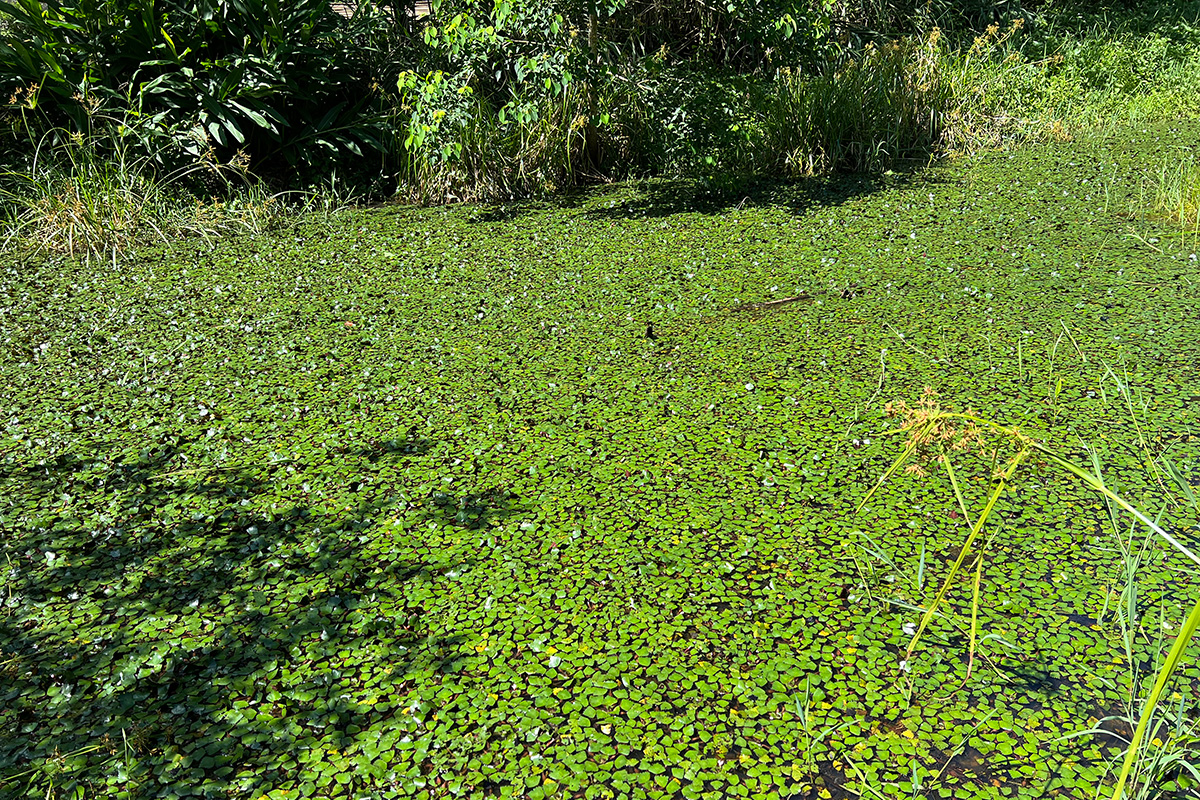
Wild water caltrop grows abundantly in areas where invasive fish species have been removed. (Photograph by Pei-jyun Shih; Photo Credit: SOW Yilan Division).
The original text is reprinted from the News & Market—Protecting the World's Precious “Floating Islands”, Shuanglianpi Becomes a Sanctuary for Rare and Endangered Plants, with permission from News & Market and the photo contributors.




 中
中